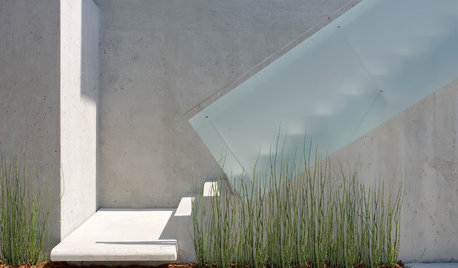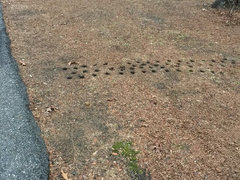Does lawn aeration work?
Kevin Bowen
8 years ago
Featured Answer
Sort by:Oldest
Comments (51)
jmoellman4
8 years agodchall_san_antonio
8 years agoRelated Discussions
Aerating options for St. Augustine lawn?
Comments (8)Thanks. I haven't fertilized in over a year, mainly because I'd been thinking that there was too much organic matter building up causing the "loose runners". The last time I think I used the equivalent of Scott's bonus S, but it may have been 16-4-8. One thing I have noticed is that the areas where I fertilize palms with palm fertilizer (8-8-6, I think) are thicker and deeper green. Anyway, despite not having fertilized, the grass is fairly green where there is mostly grass, but there are lots of weeds. No brown spots. In other areas, there are mostly weeds. Grubs will begin chewing in the next couple of months though. Still haven't found anything that controls them effectively. I water twice weekly for 40 minutes per zone using mist head sprinklers. Unless it has rained and I skip watering. I used to mow very frequently, but cut back on that, again thinking of build up of organic matter. Although, I usually bag. I rarely let it get so long that it *really* needs it. Mower is set at the 4th of 6 settings. Lawn was mowed just a few days ago, so there are no runners growing on top yet. I'll try to update this with photos when they appear. Thanks again....See MoreLawn aerators
Comments (17)>>Morph can you expand on the idea of "juicy, weak growth" in the spring? Most people would be surprised by this because everybody is told to fertilize in the spring. Tell me about it. This is probably the one concept we get the most resistance on. And I cringe every year when the Scott's "Feed your lawn! Feed it!" ads are on in March. This is for northern grasses like we have. Southern grasses like Bermuda have very different feeding patterns. Your lawn stores carbohydrates in its root system for winter survival. By spring, amounts of these are down, but there are still plenty to fuel growth through May. Grass growth in April and early May is always very, very strong as the grass is attempting to grow to its genetic height (usually anywhere from 18" to 36" depending on the cultivar). It's using the remaining carbohydrate storage to fuel that. Adding nitrogen at this stage just accelerates the growth, and speeds up how fast the stored carbohydrates tap (nitrogen is not common in nature and plants are geared to absorb everything they can get and use it). As the roots tap, they die off and slough. For feeder roots, that's not a major issue as this will happen anyway. For larger roots, it's a problem as it reduces their ability to tap water from the soil. Genetically speaking, grasses don't care about summer performance. By then, they've seeded out and the seeds just need to develop and age a bit, then fall to the ground and get ready to sprout when the weather shifts in fall. So in nature, tapping the root systems and looking terrible in July isn't a problem (and why some grasses have dormancy mechanisms to survive the [dry] summer). We don't like that tendency, so avoiding excess N in spring will help with this. Faster growth on anything tends to be weaker, more watery, and less well-defended. Overfeed any plant with nitrogen and you'll see that as the internode lengths increase drastically, and the stems become easy to bend and a bit weak. You've now created a weakened grass with a ton of available mass. Herbivorous insects now move in to eat it (it's there, there's a lot of it, it's an invitation). Breaks in the structure also allow disease to move in and set up light housekeeping--disease fungi love that. Holding off feeding until May when growth slows puts the nitrogen to a different use. Instead of fueling growth, the grass is shifting to summer mode where it stores energy to survive the dry and hot periods. Rather than decrease summer performance, you're increasing it a little. Summer is a "hang on and survive" period for grasses, so sparking growth by feeding isn't a good idea here either. Similarly, fall doesn't light off nearly the growth surge that spring does, so feeding tends to go to carbohydrate storage, root growth, and general health. That last fall feeding when the grass is no longer growing is actually the most important--the very vast majority of it will go directly to carbohydrate storage (the rest goes to root growth, which continues right up to ground freeze). That's providing energy to survive the winter, and to support normal growth rates in spring. These rules are for synthetics...nature provides very few fast nitrogen sources to plants (urea and blood being the only two I can think of offhand). Most natural sources are slow to very slow, and don't cause these issues. Organic feeding simulates a more natural feeding regimen, while still holding feeding levels high (as they have to be for our not very natural lawns). We stress the heck out of these things by mowing them constantly, planting densely, and demanding a weed-free environment....See MoreCore aerating lawn under trees?
Comments (15)Sorry but that is not at all correct. Core aeration is not for just thatch removal (that's what power dethatcher attachments or thatching rakes are all about). Ask any lawn care professional and they will outline the benefits of aeration. A core aerator does not "poke holes" in the soil - it actually removes a 3" long (or more) plug of soil/thatch/lawn all over the treated area. If these plugs are left to breakdown and decompose and a thin layer of fine bark or compost is spread over the area, textural components of organic matter work their way down into the soil via these empty 'cores', loosening the soil and opening up pore space (that's why they call it "aeration"), allowing for deeper penetration of water and lawn roots which further loosen the soil. Core aeration will certainly help in reducing thatch build up (so will using a mulching mower) but that is not its primary intent. Here is a link that might be useful: professional turf care take on the benefits of core aeration...See MoreLawn Aeration - Pflugerville, TX
Comments (2)We do it in late February / early March for St Augustine sod. Not sure of benefit of summer aeration, may promote root dryness, which not good. You have provided good caution about doing this when soil too dry, esp. If clay soil, but also unwise when soil too soft. We've done it in such conditions and the plugs stick to your shoes and make a holy mess!...See MoreAdam Bray
8 years agolast modified: 8 years agonewtolawncare Scranton 6a
8 years agoUser
8 years agodarktower00844
8 years agoowlnsr
8 years agolast modified: 8 years agoowlnsr
8 years agonewtolawncare Scranton 6a
8 years agoUser
8 years agoreeljake
8 years agodanielj_2009
8 years agoUser
8 years agoowlnsr
8 years agolast modified: 8 years agodanielj_2009
8 years agodanielj_2009
8 years agoUser
8 years agoUser
8 years agolast modified: 8 years agodanielj_2009
8 years agodanielj_2009
8 years agolast modified: 8 years agoUser
8 years agolast modified: 8 years agodanielj_2009
8 years agoUser
8 years agoUser
8 years agolast modified: 8 years agodanielj_2009
8 years agolast modified: 8 years agoUser
8 years agolast modified: 8 years agodanielj_2009
8 years agoUser
8 years agodanielj_2009
8 years agogreendave79
8 years agoUser
8 years agolast modified: 8 years agodchall_san_antonio
8 years agoowlnsr
8 years agodanielj_2009
8 years agodanielj_2009
8 years agoowlnsr
8 years agolast modified: 8 years agokbinmd
7 years agodanielj_2009
7 years agoGreen Machine
7 years agolast modified: 7 years agoowlnsr
7 years agolast modified: 7 years agoUser
7 years agolast modified: 7 years agodanielj_2009
7 years agodchall_san_antonio
7 years agoreeljake
7 years agoniziurski53
7 years agoowlnsr
7 years agodchall_san_antonio
7 years agodanielj_2009
7 years agodanielj_2009
7 years agolast modified: 7 years ago
Related Stories

LANDSCAPE DESIGNGet Along With Less Lawn — Ideas to Save Water and Effort
Ditch the mower and lower your water bill while creating a feast for the eyes with diverse plantings and gathering places
Full Story
EARTH DAYThe Case for Losing the Traditional Lawn
Work less, help the environment and foster connections by just saying no to typical turf
Full Story
GARDENING GUIDESHow to Prep Your Ground for a Healthy New Lawn
Seed or sod that falls on weedy, lumpy soil is a wasted effort. Follow these steps to ensure that your new lawn will thrive
Full Story
GRASSESHow to Rock a Lawn
Weekend Project: The key to healthy grass begins with the soil. If turf works for you, here’s how to fix it and keep it looking its best
Full Story
LIFEHouzz Call: What Does Summer Look Like at Your Home?
Kids, water, sunshine, backyards, cold drinks — share photos of what summer at home means to you
Full Story
LANDSCAPE DESIGNDoes Your Landscape Need a Little ‘Cosmic Latte’?
Beige — the color of the universe — can be both building block and backdrop in a contemporary garden
Full Story
MOST POPULARWhen Does a House Become a Home?
Getting settled can take more than arranging all your stuff. Discover how to make a real connection with where you live
Full Story
FEEL-GOOD HOMEDoes Your Home Make You Happy?
How to design an interior that speaks to your heart as well as your eyes
Full Story
GARDENING GUIDESHow to Plant a New Lawn From Sod
Take the quick-start route to turf with sod; these installation guidelines will help ensure a healthy and long-lasting lawn
Full Story
BEFORE AND AFTERSSee 6 Yards Transformed by Losing Their Lawns
Wondering whether a turf lawn is the best use of your outdoor space? These homeowners did, and they found creative alternatives
Full Story








beckyinrichmond